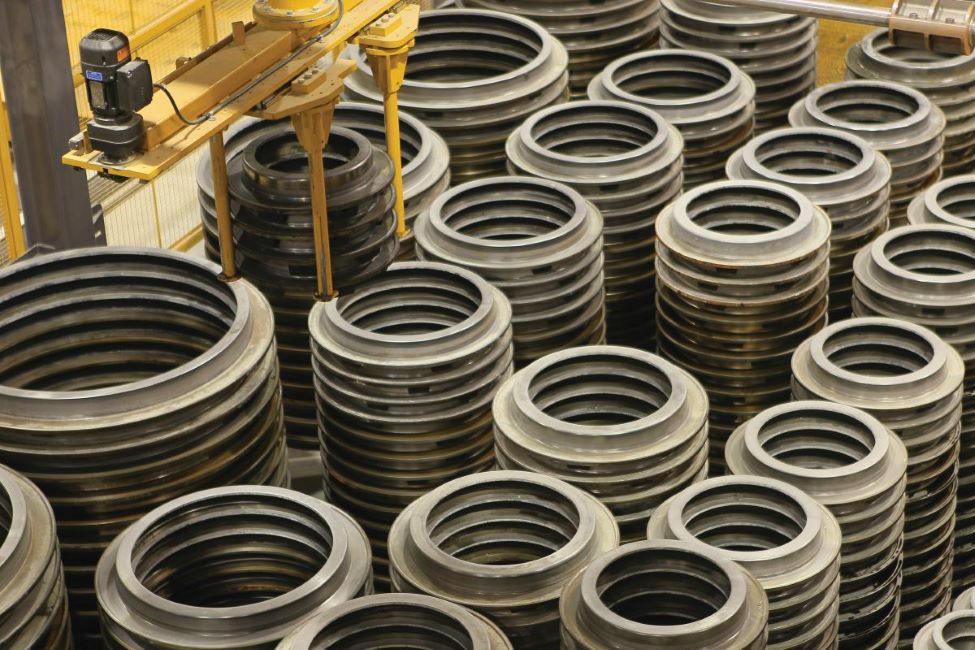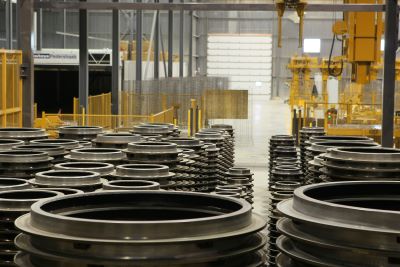
One of the most crucial elements in the production of high-quality concrete products are the joint rings (pallets, headers and set rings) that form the male and female ends of the pipes. In order to ensure the production of quality products, it is key that these joint rings are kept clean and in-shape. The flow of joint rings throughout the production process is also integral to the efficiency of a concrete factory as it is necessary for every concrete product cycle to have the right number of joint rings in the right place at exactly the right time. Afinitas’ HawkeyePedershaab and BFS joint ring handling solutions address both the quality and the efficiency issue by providing systems that automatically transport, clean and inventory the joint rings, eliminating the organizational bottlenecks and ensuring the efficient, consistent production of high-quality concrete products. Our joint ring handling systems are available either as stand-alone components, used to incrementally assist plant efficiencies, or as a part of a fully-automatic, integrated production facility.
Joint Ring Handling Equipment

Joint Ring Cleaning Systems
It is crucial to the production of high-quality spigots and bells, that the pallets and headers being used are cleaned of all residual concrete build-up. The cleanliness of the ring also is directly related to its ease of removal. In order to ensure quick joint ring cleaning, Afinitas takes a multi-cleaning brush approach with each brush simultaneously cleaning a different surface of the ring. This allows for a thoroughly cleaned ring in a cycle time that will not slow down the entire system. Another advantage of Afinitas’ HawkeyePedershaab and BFS systems is that they use pneumatics to control the pressure of the brush, compensating for brush wear and allowing for adjustable cleaning pressures for different size rings. In addition, our pallet cleaners use a scraper to clean the critical underside of the top flange to prevent it from damaging neoprene core seals.
BFS Puma Base Ring Pallet Cleaning System
Fully automated, multi-axis-controlled cleaning robot for gentle and rapid cleaning of base pallets. Special scrapers carefully scrape both coarse and fine concrete residues from inner and outer edges. A rotating, CNC-controlled, steel wire brush cleans the profile of the base ring pallet. Brush pressure is regulated automatically and remains constant even when brushes show wear. Operators can set up the BFS PUMA for the cleaning of new base pallet types or new diameters themselves with the aid of simple teach-in programming. Powerful dust extraction systems and machine housings are available as additional options.

Joint Ring Inventory Systems
After automatic removal and cleaning of the pallets and headers (joint rings), our space-saving inventory systems stock the joint rings in tall stacks, either stored for future use or returned to the production machinery for the next cycle – all without human intervention. High-speed joint ring stacking manipulators precisely maneuver the pallets and headers into and out of inventory as well as carefully stack the joint rings in 3.5m (12’) tall stacks.
- Eliminates manual labor associated with handling of pallets and headers including stacking, storage and return to machine
- Protects joint rings from damage resulting from manual mishandling
- Save building space with tight-footprint inventory area
- Capable of handling round, square, oval or arch-shaped headers

Joint Ring Oiling
Before the pallet or header is introduced back to the production machine, a release agent needs to be applied to it to ensure easy removal the following day. Afinitas provides a number of automated solutions to this task, including both dipping and spraying systems. Our spray oilers use wands that automatically adjust to all joint ring sizes and apply the release agent to all concrete surfaces of the joint ring.
- Eliminates costly plant labor
- Automatic adjustment to all joint ring sizes
- Capable of handling round, box, arch and oval headers and pallets
- Adaptable to a full range of plant layouts




